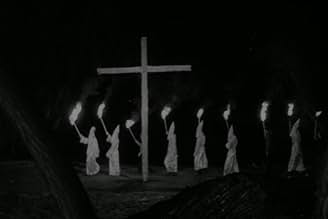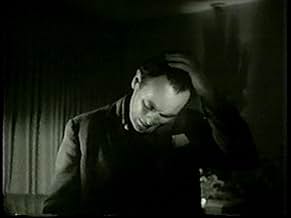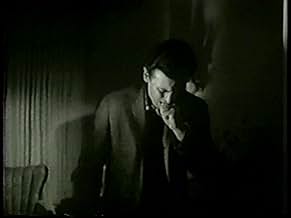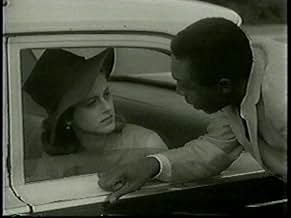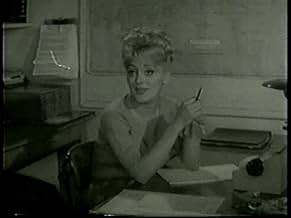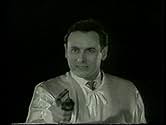Aggiungi una trama nella tua linguaAfter a black man's daughter is killed by the KKK, he seeks revenge by becoming a Klansman.After a black man's daughter is killed by the KKK, he seeks revenge by becoming a Klansman.After a black man's daughter is killed by the KKK, he seeks revenge by becoming a Klansman.
James McEachin
- Lonnie
- (as Jimmy Mack)
W. McLennard
- Wallace
- (as William McLennard)
R.L. Armstrong
- Jenkins
- (as Tex Armstrong)
Recensioni in evidenza
Oh, this film has flaws all right: Sloppy edits, phony day-for-night, zero budget, and a lot of bad acting. The ending is a bit syrupy as well. But it takes up fascinating questions and plunges headlong into the dark side of American racism, showing KKK meetings, burning crosses, and violence. It treatment of the race question reminds me of the Roger Korman film "The Outsider," in which William Shatner plays a white racist, but in this case a light-skinned black man goes under cover to join the ranks of prejudice. This film's combination of thematic boldness and slipshod execution makes it wonderfully horrible. Or horribly wonderful, I can't figure out which.
What can be said? This movie is as disturbing now as it was when it was made. But the acting is so irregular. Sometimes it's comically bad which makes it extremely uncomfortable. The ending is also disappointing.
The legendary schlock director, creator of such memorable productions as "Astro-Zombies" and "The Doll Squad", actually takes himself seriously for this reasonably effective, interesting comment on race relations in the deep South, circa 1966. This is a time when a civil rights law had been passed, and the white people in this story are none too happy about that. Some of the Klansmen in the small Alabama town of Turnerville try to fire bomb a church and kill the daughter of a man named Jerry Ellsworth (Richard Gilden). Jerry, you see, is a light skinned black who realizes that he could pass for white, so he does so and manages to infiltrate the KKK so that he can get his revenge.
One might have a hard time believing that this is the same Mikels who made those other pictures. It works pretty well, and one can get caught up in the story, written by John T. Wilson and Art Names, and be eager to see the antagonists get their just desserts. This is all done in a very straightforward, no frills manner, and it does get a lot of juice from a standout characterization by Max Julien, later star of "The Mack", as a young revolutionary with a "by any means necessary" type of approach. His scenes are the best in the movie. But star Gilden ('Death Valley Days') does a decent job as well. Harry Lovejoy as Rook is good at playing just the sort of guy who deserves his comeuppance. James McEachin (star of the short-lived 'Tenafly' TV series) makes a strong film debut as Lonnie. Look for Byrd Holland, also the makeup artist on this show, in a small role as the mayor, and B movie legend Gary Kent as Wilkins.
Sharp cinematography by Robert Caramico and atmospheric music by Jaime Mendoza-Nava are solid attributes, and the movie comes complete with a theme song that's a real hoot.
I agree with another review here: it would be too easy to dismiss this as mere exploitation; it does have more depth than some people would expect. It's worth a look.
Eight out of 10.
One might have a hard time believing that this is the same Mikels who made those other pictures. It works pretty well, and one can get caught up in the story, written by John T. Wilson and Art Names, and be eager to see the antagonists get their just desserts. This is all done in a very straightforward, no frills manner, and it does get a lot of juice from a standout characterization by Max Julien, later star of "The Mack", as a young revolutionary with a "by any means necessary" type of approach. His scenes are the best in the movie. But star Gilden ('Death Valley Days') does a decent job as well. Harry Lovejoy as Rook is good at playing just the sort of guy who deserves his comeuppance. James McEachin (star of the short-lived 'Tenafly' TV series) makes a strong film debut as Lonnie. Look for Byrd Holland, also the makeup artist on this show, in a small role as the mayor, and B movie legend Gary Kent as Wilkins.
Sharp cinematography by Robert Caramico and atmospheric music by Jaime Mendoza-Nava are solid attributes, and the movie comes complete with a theme song that's a real hoot.
I agree with another review here: it would be too easy to dismiss this as mere exploitation; it does have more depth than some people would expect. It's worth a look.
Eight out of 10.
It was a rare occasion in 1960's American cinema that the screen would reflect the social turbulence surrounding the civil rights movement, or the fundamentally tense race relations in particularly in the southern states. The white supremacist organisation, the Ku Klux Klan, was a dominant and violent presence which was largely controlled and operated by the local powers of small towns and cities. Whilst the subject was on the surface of the film adaptation of Harper Lee's Pulitzer prize winning novel, To Kill a Mocking Bird (1962), but the cinema mainstream was hardly representative of social conscience until Stanley Kramer's Guess Who's Coming to Dinner (1967). But a few low budget b-movies in the early '60's did attempt to tackle the subject. Roger Corman's under- seen William Shatner starer, The Intruder (1962), or Carl Lerner's Black Like Me (1964), whilst unsuccessful, at least attempted an intelligent, left-field approach. So it seems almost astounding with hindsight, that Ted V. Mikels, shlock director of later atrocities like The Astro- Zombies (1968) or The Doll Squad (1973), would produce a film that would formulate a film that is both sensitive and intelligent about the deep- seated racism within southern state America.
The film opens in the small town of Turnersville, a young, dumb kid walks into an all white diner, upsetting the patrons of the establishment by being the wrong colour. This small act leads to the local faction of the KKK to "retaliate" by shooting the boy then throwing Molotov cocktails at a congregation of a black church. This, along with the burning crucifix, was a reality in these small-minded towns. However, on throwing the fiery bottle at the doorway, the perpetrator witnesses a very young girl being hit directly with the weapon. The father of the girl, travelling musician Jerry Ellsworth (also notably of mixed race - but played by a white actor), heads to the town on hearing the news. Jerry takes himself to a hair salon and transfers himself into a white man (for all intents and purposes). He charms his way into the life of KKK head, and infiltrates the organisation, biding his time to reap revenge on the evil that killed his daughter.
It is of course a ludicrous concept, but the film offers quite emotional and sometimes dramatic scenes. Jerry is also accompanied by a white woman, Andrea (Rima Kutner), who is in love with him and wants a baby with him (something that an alternative title for the film overly focused on, I Crossed the Color Line). This alone would have been a controversial inclusion to the film, but it also balanced this with a more critical commentary on vigilante justice, and mob organisation (particularly on the black group formed in reaction to the attack). The opening scenes where the KKK shoot the young black boy are truly shocking for its time and budget, a scene that resembles the later opening scenes of Mississippi Burning (1989), which are shot quite similarly, staring starkly in the face of the victim. This is not to say that the film is wholly satisfactory, in true Mikels style the film is technically horrific; bad editing, uninspired camera work, the inevitable bad arrangement of scenes and characters. But, at its heart is something quite remarkable. Not revelatory, or even particularly exciting, but nonetheless, the central theme of social segregation is still relevant today (shockingly), and surprisingly some of the acting ain't too bad.
www.the-wrath-of-blog.blogspot.com
The film opens in the small town of Turnersville, a young, dumb kid walks into an all white diner, upsetting the patrons of the establishment by being the wrong colour. This small act leads to the local faction of the KKK to "retaliate" by shooting the boy then throwing Molotov cocktails at a congregation of a black church. This, along with the burning crucifix, was a reality in these small-minded towns. However, on throwing the fiery bottle at the doorway, the perpetrator witnesses a very young girl being hit directly with the weapon. The father of the girl, travelling musician Jerry Ellsworth (also notably of mixed race - but played by a white actor), heads to the town on hearing the news. Jerry takes himself to a hair salon and transfers himself into a white man (for all intents and purposes). He charms his way into the life of KKK head, and infiltrates the organisation, biding his time to reap revenge on the evil that killed his daughter.
It is of course a ludicrous concept, but the film offers quite emotional and sometimes dramatic scenes. Jerry is also accompanied by a white woman, Andrea (Rima Kutner), who is in love with him and wants a baby with him (something that an alternative title for the film overly focused on, I Crossed the Color Line). This alone would have been a controversial inclusion to the film, but it also balanced this with a more critical commentary on vigilante justice, and mob organisation (particularly on the black group formed in reaction to the attack). The opening scenes where the KKK shoot the young black boy are truly shocking for its time and budget, a scene that resembles the later opening scenes of Mississippi Burning (1989), which are shot quite similarly, staring starkly in the face of the victim. This is not to say that the film is wholly satisfactory, in true Mikels style the film is technically horrific; bad editing, uninspired camera work, the inevitable bad arrangement of scenes and characters. But, at its heart is something quite remarkable. Not revelatory, or even particularly exciting, but nonetheless, the central theme of social segregation is still relevant today (shockingly), and surprisingly some of the acting ain't too bad.
www.the-wrath-of-blog.blogspot.com
Though I never heard of any of the actors except the excellent James McEachin, nearly every single player gives a good to excellent performance.
It starts rather badly, and my thoughts were negative about the director, Ted V. Mikels, whose work is apparently mostly exploitative, and the nominal lead, Richard Gilden. But after a few more scenes, everything shifts into a higher gear and actors and director present us with a good movie.
At this writing, March of 2019, the film is 53 years old. Most of the worst aspects of the problem presented by the story have receded. While Ku Klux Klan and similar organizations still exist, they are generally discounted by most of the rest of the population.
Except: the U.S. "news" media and other Democrats and other left-collectivists would have us believe that every problem in these United States derives from "racism" and that most people, especially those who don't buy into the left-collectivist belief system, are "racists."
In addition, among the left-collectivists, including the "news" media, there is a sickening and disgusting emphasis placed on group identity, which is, in fact, what is wrong with such groups as the KKK, but is somehow accepted when it's from Democrat candidates.
In fact, each of us is an individual, no matter what our skin color. And one point made in this film is that the protagonist, with one black parent, looks white enough to be allowed membership in the Klan.
Not stressed in this movie is the notion that one's skin color or ethnicity cannot lead to any particular belief system. But it's a fact.
Yes, one's culture, one's neighbors, one's schooling can certainly bend a person's thinking, but not that person's skin color, not race or ethnicity.
The premise of this mostly very well-done motion picture is excellent, it's timely, even after the decades since its premiere. The acting is first class, its picture of the rituals of the KKK certainly look real, almost, in spots, like a documentary.
I highly recommend this movie, under whichever title, even if the ending is a bit ambiguous. Very, very well done.
It starts rather badly, and my thoughts were negative about the director, Ted V. Mikels, whose work is apparently mostly exploitative, and the nominal lead, Richard Gilden. But after a few more scenes, everything shifts into a higher gear and actors and director present us with a good movie.
At this writing, March of 2019, the film is 53 years old. Most of the worst aspects of the problem presented by the story have receded. While Ku Klux Klan and similar organizations still exist, they are generally discounted by most of the rest of the population.
Except: the U.S. "news" media and other Democrats and other left-collectivists would have us believe that every problem in these United States derives from "racism" and that most people, especially those who don't buy into the left-collectivist belief system, are "racists."
In addition, among the left-collectivists, including the "news" media, there is a sickening and disgusting emphasis placed on group identity, which is, in fact, what is wrong with such groups as the KKK, but is somehow accepted when it's from Democrat candidates.
In fact, each of us is an individual, no matter what our skin color. And one point made in this film is that the protagonist, with one black parent, looks white enough to be allowed membership in the Klan.
Not stressed in this movie is the notion that one's skin color or ethnicity cannot lead to any particular belief system. But it's a fact.
Yes, one's culture, one's neighbors, one's schooling can certainly bend a person's thinking, but not that person's skin color, not race or ethnicity.
The premise of this mostly very well-done motion picture is excellent, it's timely, even after the decades since its premiere. The acting is first class, its picture of the rituals of the KKK certainly look real, almost, in spots, like a documentary.
I highly recommend this movie, under whichever title, even if the ending is a bit ambiguous. Very, very well done.
Lo sapevi?
- QuizMax Julien (Raymond) and Whitman Mayo (Alex) are both members of Kappa Alpha Psi Fraternity Inc.
- ConnessioniFeatured in The Wild World of Ted V. Mikels (2008)
- Colonne sonoreThe Black Klansman
By Tony Harris
I più visti
Accedi per valutare e creare un elenco di titoli salvati per ottenere consigli personalizzati
- How long is The Black Klansman?Powered by Alexa
Dettagli
Botteghino
- Budget
- 80.000 USD (previsto)
- Tempo di esecuzione1 ora 28 minuti
- Colore
- Mix di suoni
- Proporzioni
- 1.85 : 1
Contribuisci a questa pagina
Suggerisci una modifica o aggiungi i contenuti mancanti

